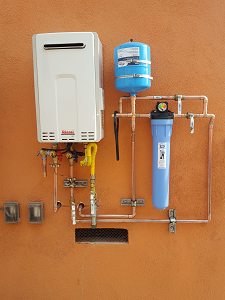How do Anode Rods work?
It is amazing how quickly metal can rust when it is in contact with water. This leads to a puzzling question, why does your water heater not just rust away in a few years? The answer is the anode rod. Since your water heater is constantly exposed to water, it is vulnerable to rust and needs protection… this comes in the form of what is known as an sacrificial anode rod as it “sacrifices” itself to SAVE your water heater from rusting.
What is an Anode Rod?
The long metal anode rod inside your water heater tank is usually made of magnesium or aluminum around a steel wire. The anode rod is inserted into the water tank in contact with the water. The purpose of the rod is to attract the rust causing ions in the water. Over time, the rod will degrade, and once it has been reduced down to the wire core, it is no longer effective. The typical lifespan of an anode rod is only two to three years. This means that with a ten year typical lifespan of the heater, you will need to replace the anode rod, at least, three times.
How the Anode Rod Protects the Tank
To understand how an anode rod protects your water heater tank, you need to understand a basic scientific principle. When two metals are in contact in a water solution, they will not both rust. The more reactive metal will corrode completely before the second metal begins to rust. Since aluminum and magnesium are far more reactive compared to the steel used to make the tank, it stands to reason that the rod will corrode and leave the tank protected.
Options for Your Anode Rod
There are two types of anode rod. Combo anodes are integrated into the delivery assembly of the hot water tank while hex-head models screw into the tank to extend into the water. Generally, water heaters are sold with either only a hex-head anode rod or with both rods. These days magnesium anodes are more common than aluminum. The reason for this is that when aluminum corrodes it leaves a gunky waste that can clog water pipes and compromise the lifespan of the unit. Aluminum anodes can also swell as they rust, making them difficult to remove and replace.
Replacing Your Anode Rod
Since the anode rod is vital to protecting your hot water heater tank from rust, it is important that it be regularly checked. Plumbing experts recommend checking the anode rod at least once a year. This is a simple process and only requires you to open up the tank and assess the rod visibly. If the steel wire core is visible, the rod has reached the point of being too corroded and needs to be replaced. Anode rods are not interchangeable, so if your anode rod needs to be replaced, you will need to find the right one for your unit. You will need to consult your owner’s manual or manufacturer to check which anode rods are compatible with your unit. Fortunately, most plumbing specialists will incorporate replacing the anode rod into their annual service plans, so you won’t have to worry about replacing it yourself.
By Giovanni Longo President Flood Brothers Plumbing
Giovanni Longo is a 3rd generation master plumber who has been practicing his craft and trade in the greater Los Angeles area for well over a decade and a half. A plumbing and hydraulics-engineering innovator, Giovanni’s particular world-class expertise focuses on dealing with challenging sewer system designs as well as resolving complex commercial and residential draining issues. As a certified Flood Mitigation expert, he is also well versed in a wide variety of water damage and remediation solutions.





